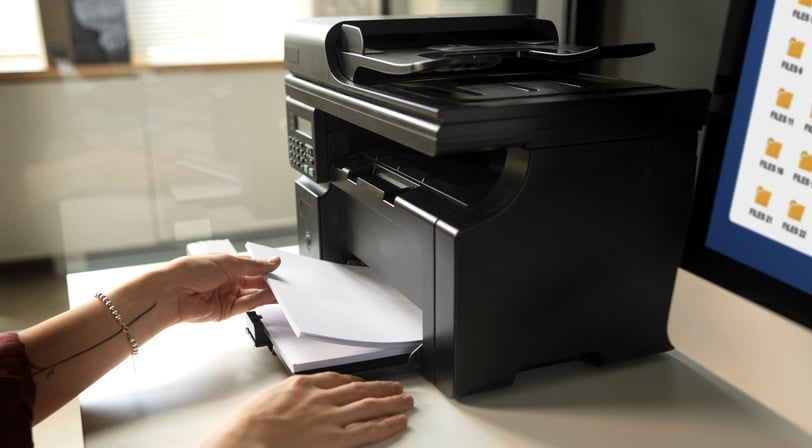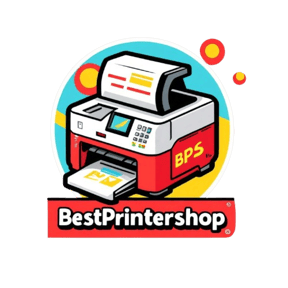Automatic Document Feeder: Benefits, Features & Buying Tips
Discover the benefits, features, cost considerations, and tips for selecting the best automatic document feeder (ADF) printer for your business.
Praveen Kumar - Canon Printer Specialist
12/13/202410 min read


The Challenge of Document Management in Today's World
Meeting the demands of today's fast-paced world requires efficient document management, yet traditional paper-handling methods often create frustrating bottlenecks in our workflows. The familiar scenario of waiting by a printer, manually feeding documents, or dealing with paper jams not only wastes precious time but also hampers productivity, especially in space-constrained small offices and home setups. This is where printers equipped with an Automatic Document Feeder (ADF) make a transformative difference, offering a streamlined solution for automatically processing multiple pages during scanning, copying, and faxing tasks. In this blog, we'll explore the inner workings of ADF technology, its numerous benefits, and how it can revolutionize your document management practices to save time, reduce errors, and boost overall efficiency.
1. What is an All-in-One Printer?
An All-in-One (AIO) printer is exactly what the name suggests: a single machine that combines multiple functions in one device. Typically, these printers offer printing, scanning, copying, and faxing capabilities. Whether you need to print documents, make copies, or scan them to your computer, an all-in-one printer is designed to handle it all.
Key Features of All-in-One Printers:
All-in-One Printers: Compact and Efficient
All-in-one (AIO) printers combine multiple functions like printing, scanning, and copying into one device, saving both space and money. Ideal for home offices or small businesses, these printers offer a compact design to fit limited spaces.Ease of Use
Modern AIO printers feature intuitive interfaces, often with touchscreens, making tasks like scanning and copying hassle-free.Wireless Connectivity
With Wi-Fi, Bluetooth, and sometimes NFC, AIO printers allow seamless printing from smartphones, tablets, or laptops without the need for cables.
Why Choose an All-in-One Printer?
Cost-Effective: Save money by combining multiple functions—printing, scanning, and copying—into one device instead of buying separate machines.
Time-Saving: Features like automatic document feeders (ADF) enable quick handling of large document volumes, saving valuable time.
Space-Saving: Ideal for small spaces, AIO printers reduce clutter by merging several devices into a single compact unit.
Versatile: From printing photos to scanning and copying documents, an AIO printer handles diverse tasks with ease.
While perfect for general home or office use, specialized needs like high-volume printing or professional-quality photos may require dedicated printers.
2. Understanding the Automatic Document Feeder (ADF) in Printers
The Automatic Document Feeder (ADF) is a feature that significantly enhances the functionality of modern printers, particularly all-in-one devices. It’s a small but powerful addition that allows the printer to automatically load multiple pages for scanning, copying, or faxing, without the need for manual intervention.
What is an ADF?
In simple terms, an ADF is a device integrated into the printer that feeds paper into the printer's scanner automatically. Unlike traditional flatbed scanners where you need to manually place each document on the glass surface for scanning or copying, the ADF allows you to load a stack of documents into the feeder tray, and the printer will scan, copy, or fax them one after another.
Types of ADFs
There are typically two types of ADFs you’ll encounter:
Single-Sided ADF:
A single-sided ADF can scan or copy only one side of the paper at a time. After scanning one side, the document will need to pass through again to scan the other side, if required. This process is typically slower than double-sided scanning.
Duplex (Double-Sided) ADF:
A duplex ADF is much more efficient. This feature is especially useful when dealing with double-sided documents, as it saves time and reduces the number of times the paper needs to be fed through the printer.
Benefits of ADF
The ADF feature offers several advantages, making it an essential tool for anyone who frequently handles multi-page documents:
1. Time-Saving:
ADF printers save time by automating the scanning or copying of multi-page documents. Simply load the stack, and the printer handles the rest—no need for manual page placement.
2. Increased Productivity:
Perfect for small offices or home businesses, ADF printers allow you to multitask while handling large batches of documents for scanning, copying, or faxing.
3. Reduces Errors:
ADF automation minimizes paper jams, misfeeds, and manual errors, ensuring smoother operation and better workflow efficiency.
4. Better Document Management:
Quickly digitize or copy multi-page documents for easy storage and retrieval, eliminating the hassle of scanning pages individually.
5. Compact and Versatile:
Modern ADFs are user-friendly and support various paper sizes, including letter, legal, and even cards, making them practical for diverse document needs.
Practical Examples of How ADF Makes Life Easier
1. Scanning and Archiving:
An ADF makes digitizing large document stacks effortless. Place your records in the feeder, and it scans each page automatically, saving time when archiving old files.
2. Copying Multiple Pages:
Forget manually copying page by page. An ADF allows quick scanning and copying of multiple pages, perfect for reports, contracts, or presentations in busy office settings.
3. Faxing Large Batches:
Even in the digital age, faxing remains essential for some businesses. An ADF streamlines the process by faxing multiple pages in one go, avoiding manual feeding.
3. ADF Printers: A Comprehensive Guide
Choosing the right ADF printer can be a challenge given the wide range of options available in the market. With features ranging from basic single-sided scanning to advanced double-sided scanning, it's essential to understand your specific needs before making a decision. In this section, we’ll explore the different types of ADF printers and offer guidance on how to select the best one for your personal or business use.
Types of ADF Printers
When shopping for an ADF printer, you’ll come across several key features and variations. Let’s take a look at some of the most common types of ADF printers available today.
1. Single-Sided ADF Printers:
These scan one side at a time and require flipping the paper for double-sided scanning. While more affordable, they are slower and best for personal or low-volume tasks like newsletters or single-page documents.
2. Duplex (Double-Sided) ADF Printers:
Duplex ADF printers scan both sides of a page in one pass, saving time and enhancing efficiency. They're ideal for offices handling double-sided documents, such as contracts or reports.
3. Flatbed ADF Printers:
These combine an ADF with a flatbed scanner, offering flexibility for scanning thick or bound materials (e.g., books) alongside standard documents. Perfect for diverse scanning needs.
4. Multi-Function ADF Printers:
All-in-one devices that print, scan, copy, and fax, equipped with ADF. Ideal for businesses or home offices, they save space and handle multiple tasks efficiently.
Key Features to Consider When Choosing an ADF Printer
When selecting an ADF printer, it’s important to keep your specific needs in mind. Here are a few key features to consider to ensure you're getting the best machine for your requirements:
1. Paper Capacity:
ADF paper capacity ranges from 20 pages in budget models to 100+ pages in premium ones. High-capacity feeders are ideal for handling large document volumes efficiently.
2. Print Speed:
Measured in pages per minute (ppm), high-speed printing and scanning are essential for users managing large batches of documents regularly to maintain productivity.
3. Connectivity Options:
Wireless features like Wi-Fi, Bluetooth, or cloud printing enable seamless printing and scanning from smartphones, tablets, or laptops, offering convenience and flexibility.
4. Scan Resolution:
Higher scan resolutions (measured in dpi) provide clearer, detailed images. Opt for a high-resolution printer if your work involves scanning photos or detailed documents.
5. Size and Footprint:
Compact models are perfect for home offices, while larger, more robust devices suit businesses requiring high document throughput.
6. Price:
Prices vary based on features. Budget models cover basic needs, while high-end printers with advanced capabilities like duplex scanning and cloud connectivity cost more. Choose one that balances features with your budget.
How to Choose the Best ADF Printer
To help narrow down your choices, consider the following questions:
What is the volume of documents you need to process?
If you’re dealing with a high volume of documents daily, you’ll need a printer with a larger ADF capacity, faster printing/scanning speeds, and possibly duplex functionality.Do you need to scan or copy double-sided documents regularly?
If you work with double-sided documents, a duplex ADF printer is essential for saving time. Single-sided printers are fine for simpler, single-page tasks.What is your budget?
ADF printers come in a wide price range, so make sure to consider how much you are willing to invest. While more expensive models offer faster speeds and higher-resolution scans, budget models still offer basic ADF functionality for casual or low-volume users.What additional features do you need?
If you need additional capabilities, such as wireless printing, cloud storage, or compatibility with mobile devices, make sure the printer you select offers those features.
By considering these factors, you can find an ADF printer that fits your needs and enhances your document management process, saving you both time and effort.


4. The Role of ADF in Improving Printer Productivity
In today’s fast-paced world, productivity is everything. Whether you're managing a small home office or running a large business, time is a valuable commodity. The Automatic Document Feeder (ADF) is one of the most significant advancements in printing and document management technology, designed to boost productivity by automating tedious tasks and reducing the manual intervention required in scanning, copying, and faxing.
How ADF Technology Enhances Productivity
1. Reduces Time Spent on Manual Tasks:
An ADF-equipped printer saves valuable time by automating scanning, copying, and faxing. Instead of manually loading each page, simply load a stack of documents and let the ADF process them. This allows you to focus on other tasks while the printer works.
2. Increases Workflow Efficiency:
ADF printers enable hands-free, continuous document processing, reducing downtime and allowing your team to stay productive. This continuous workflow is ideal for tasks like scanning invoices or copying large contracts, keeping operations smooth.
3. Batch Processing Made Easy:
High-capacity ADFs (50-100 pages) make batch processing effortless, allowing businesses to scan or copy large volumes of documents quickly. This is particularly helpful for organizations handling administrative tasks or creating digital records.
4. Enhances Collaboration:
Fast document handling with ADF allows quick sharing of scanned or copied documents. Team members can easily share documents via email or cloud storage, improving collaboration and enabling remote access.
5. Improved Document Handling with Fewer Errors:
ADF printers reduce errors such as paper jams or misfeeds by automatically feeding documents. Error detection features help ensure smooth document processing, improving accuracy and reducing interruptions.
6. Consistency and Reliability:
With ADF, documents are processed the same way each time, ensuring consistent results. These printers are designed to handle high-volume tasks reliably, without frequent interruptions, making them ideal for fast-paced environments.
Practical Examples of Productivity Gains with ADF
Managing Invoice Processing:
For businesses, invoice processing can be time-consuming. Instead of manually scanning each invoice, an ADF printer allows you to scan multiple invoices in one batch. These scanned documents can then be easily organized and stored in the cloud, enabling quick access by the accounting team and speeding up the payment cycle.
Handling Client Contracts:
For businesses like law firms that handle extensive client paperwork, ADF technology is invaluable. It simplifies the process of scanning and copying long contracts and legal documents, enabling employees to complete these tasks faster. This efficiency allows more time for important activities such as drafting and negotiating documents.
Automating Document Archiving:
Many industries require the storage of large volumes of documents for legal or regulatory compliance. ADF printers simplify digitizing paper records by allowing employees to feed stacks of documents into the printer for quick scanning and storage in digital archives. This automation reduces manual effort and helps maintain organized, easily accessible records.
Remote Document Collaboration:
ADF-equipped printers can send scanned documents directly to email, cloud storage, or shared drives, facilitating remote document collaboration. This capability enables employees, teams, and external stakeholders to access and work on documents from anywhere, ensuring seamless communication and collaboration across departments and locations.
5. How ADF Technology Improves Productivity in Copiers and Printers
While Automatic Document Feeders (ADFs) are commonly associated with printers, they are also a critical component of copiers. ADF technology plays an important role in enhancing productivity for both types of devices by automating the handling of documents, which eliminates time-consuming manual tasks. In this section, we will explore how ADF printers and copiers improve productivity and why incorporating ADF technology into your office environment can streamline operations.
ADF Technology in Copiers
Copiers are widely used in offices, and their primary function is to replicate documents. The addition of an ADF to copiers enhances this basic function by allowing the copier to handle multiple documents automatically, just like it does in printers. Here’s how ADF-equipped copiers boost productivity:
Continuous Copying of Multiple Pages:
An ADF-equipped copier streamlines the process of copying multi-page documents by allowing you to load a stack of pages into the feeder. The copier automatically processes each page, generating multiple copies without manual intervention. This is a significant time-saver, especially when working with large documents. In busy office environments, where documents need to be copied frequently, ADF copiers free up employees to focus on other tasks while the copier handles the job.
Improved Workflow for Large Volume Copying:
In high-demand settings, like legal offices or corporate environments, where large volumes of copying are required, ADF technology is essential. Instead of manually placing each document on the copier, the ADF allows for continuous copying of large batches, eliminating the need for constant supervision. This makes the copier more efficient, helping businesses meet their fast-paced demands for copying hundreds of pages or just a few without interruption.
Quality Consistency in Copying:
Manual copying can often lead to quality variations, such as misalignment or poor image quality from incorrect placement on the copier glass. An ADF-equipped copier ensures consistent quality by feeding documents precisely and automatically. This guarantees uniformity in each copy, which is particularly important in professional settings where consistency and high-quality results are required for presentations, reports, and other documents.
ADF Technology in Printers
While copiers benefit from ADFs, printers also experience considerable productivity improvements when equipped with this technology. Here’s how ADF printers contribute to higher productivity in a printing environment:
Faster Document Processing:
ADF printers significantly speed up document handling by automating the process of printing, scanning, or faxing. Unlike standard printers that require manual loading for each page, ADF-equipped printers can process multiple pages in a single pass. This reduces the time spent on repetitive tasks, making it ideal for businesses with high document volumes. A faster workflow ensures that tight deadlines are met and productivity remains high, especially when dealing with bulk printing or scanning.
Efficient Scanning of Multiple Pages:
Scanning multi-page documents can be tedious when using a regular scanner, as it requires loading each page individually. With an ADF printer, you simply load a batch of pages into the feeder, and the printer automatically scans each one. This eliminates the need for manual intervention and speeds up the scanning process, especially for businesses with high volumes of paperwork. ADF printers also support batch scanning, which improves both speed and consistency in digitizing documents.
Automated Document Workflow:
For businesses with complex document management needs, ADF printers enable automation of key tasks like document archiving, sharing, and record-keeping. After scanning a document, ADF printers can automatically upload the files to cloud storage, email them to colleagues or clients, or save them for later use. This automation reduces human error, improves document organization, and speeds up overall workflow, making it an excellent choice for businesses looking to streamline their operations.
Increased Flexibility in Document Handling:
ADF printers are designed to handle a wide range of document types and sizes, including standard letter-sized pages and larger legal-sized documents. This flexibility makes it easy to manage different kinds of paperwork, such as contracts, invoices, and reports, without constantly adjusting settings or reformatting. Additionally, many ADF printers allow users to perform print, scan, copy, and fax tasks directly from the printer's control panel, saving time and enhancing workflow by eliminating the need to switch between multiple devices.
Insights
Explore the latest in printer technology and tips.
Resources
Support
contact@bestprintershop.com
+918920029543
© 2024 BestPrinterShop . All rights reserved.
